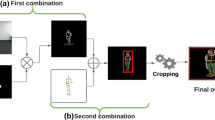Abstract
To explore the construction and evaluation of the human behavior recognition model in kinematics by deep learning, the convolution neural network (CNN) in the field of deep learning was applied to build the CNN human behavior recognition algorithm model. The image data were collected from the KTH and Weizmann datasets and trained; then, the proposed algorithm was simulated by the TensorFlow platform. The results suggested that in the analysis of recognition effect of kinematic description in two datasets, the accuracy of the histogram of optical flow orientation (HOF) method was the worst in both KTH and Weizmann datasets, while the accuracy of the constructed Visual Geometry Group-16 (VGG-16) algorithm model was the highest. In the analysis of the accuracy of the KTH dataset, the boxing action had the highest accuracy of recognition, and the running action had the lowest accuracy of recognition. The average recognition value of all kinds of actions was 91.93%. In the precision analysis of the Weizmann dataset, the bending and hand waving actions had the most accurate recognition rate, while the running action had the lowest recognition rate.









Similar content being viewed by others
References
Cha YJ, Choi W, Büyüköztürk O (2017) Deep learning-based crack damage detection using convolutional neural networks. Comput‐Aided Civil Infrastruct Eng 32(5):361–378
Chen M (2018) The research of human individual’s conformity behavior in emergency situations. Libr Hi Tech. https://doi.org/10.1108/LHT-08-2018-0113
Chen M (2019) The impact of expatriates’ cross-cultural adjustment on work stress and job involvement in the high-tech industry. Front Psychol 10:2228. https://doi.org/10.3389/fpsyg.2019.02228
Chiovetto E, Curio C, Endres D et al (2018) Perceptual integration of kinematic components in the recognition of emotional facial expressions. J Vis 18(4):13–13
Ciardo F, Campanini I, Merlo A et al (2018) The role of perspective in discriminating between social and non-social intentions from reach-to-grasp kinematics. Psychol Res 82(5):915–928
Corrigan BW, Gulli RA, Doucet G et al (2017) Characterizing eye movement behaviors and kinematics of non-human primates during virtual navigation tasks. J Vis 17(12):15–15
Dingenen B, Staes FF, Santermans L et al (2018) Are two-dimensional measured frontal plane angles related to three-dimensional measured kinematic profiles during running? Phys Ther Sport 29:84–92
Edey R, Yon D, Cook J et al (2017) Our own action kinematics predict the perceived affective states of others. J Exp Psychol Hum Percept Perform 43(7):1263
Hassan MM, Uddin MZ, Mohamed A et al (2018) A robust human activity recognition system using smartphone sensors and deep learning. Fut Gen Comput Syst 81:307–313
Ke Q, An S, Bennamoun M et al (2017) Skeletonnet: Mining deep part features for 3-d action recognition. IEEE Signal Process Lett 24(6):731–735
Kheradpisheh SR, Ghodrati M, Ganjtabesh M et al (2016) Deep networks can resemble human feed-forward vision in invariant object recognition. Sci Rep 6:32672
Kim H, Lee S, Kim Y et al (2016) Weighted joint-based human behavior recognition algorithm using only depth information for low-cost intelligent video-surveillance system. Expert Syst Appl 45:131–141
Lv X, Chai J, Xia S (2016) Data-driven inverse dynamics for human motion. ACM Trans Graph 35(6):163
Lytras MD, Raghavan V, Damiani E (2017) Big data and data analytics research: from metaphors to value space for collective wisdom in human decision making and smart machines. Int J Semant Web Inf Syst 13(1):1–10
Ohsugi H, Tabuchi H, Enno H et al (2017) Accuracy of deep learning, a machine-learning technology, using ultra–wide-field fundus ophthalmoscopy for detecting rhegmatogenous retinal detachment. Sci Rep 7(1):9425
PanK X J, Skjervøy MV, Chan WP et al (2017) Automated detection of handovers using kinematic features. Int J Robot Res 36(5–7):721–738
Patwardhan A (2017) Three-dimensional, kinematic, human behavioral pattern-based features for multimodal emotion recognition. Multimodal Technol Interact 1(3):19
Prati A, Shan C, Wang KIK (2019) Sensors, vision and networks: from video surveillance to activity recognition and health monitoring. J Ambient Intell Smart Environ 11(1):5–22
Rajalingham R, Issa EB, Bashivan P et al (2018) Large-scale, high-resolution comparison of the core visual object recognition behavior of humans, monkeys, and state-of-the-art deep artificial neural networks. J Neurosci 38(33):7255–7269
Shamur E, Zilka M, Hassner T et al (2016) Automated detection of feeding strikes by larval fish using continuous high-speed digital video: a novel method to extract quantitative data from fast, sparse kinematic events. J Exp Biol 219(11):1608–1617
Shen C-w, Ho J-t, Ly PTM, Kuo T-c (2019) Behavioural intentions of using virtual reality in learning: perspectives of acceptance of information technology and learning style. Virtual Real 23(3):313–324. https://doi.org/10.1007/s10055-018-0348-1
Shen C-w, Min C, Wang C-c (2019b) Analyzing the trend of O2O commerce by bilingual text mining on social media. Comput Hum Behav 101:474–483. https://doi.org/10.1016/j.chb.2018.09.031
Sremac S, Tanackov I, Kopić M et al (2018) ANFIS model for determining the economic order quantity. Decis Mak Appl Manag Eng 1(2):81–92
Su Y, Han L, Wang J, Wang H (2019) Quantum-behaved RS-PSO-LSSVM method for quality prediction in parts production processes. Concurr Comput-Pract Exp 9:e5522. https://doi.org/10.1002/cpe.5522
Wang Y, Widrow B, Zadeh LA et al (2016) Cognitive intelligence: Deep learning, thinking, and reasoning by brain-inspired systems. Int J Cogn Inform Nat Intell 10(4):1–20
Wu D, Pigou L, Kindermans PJ et al (2016) Deep dynamic neural networks for multimodal gesture segmentation and recognition. IEEE Trans Pattern Anal Mach Intell 38(8):1583–1597
Wu Y, Luo Y, Chaudhari G et al (2019) Bright-field holography: cross-modality deep learning enables snapshot 3D imaging with bright-field contrast using a single hologram. Light Sci Appl 8(1):25
Yang T, Gao X, Gao R et al (2019) A Novel Activity Recognition System for Alternative Control Strategies of a Lower Limb Rehabilitation Robot. Applied Sciences 9(19):3986
Zheng Y, Ke H (2020) The adoption of scale space hierarchical cluster analysis algorithm in the classification of rock-climbing teaching evaluation system. J Ambient Intell Hum Comput. https://doi.org/10.1007/s12652-020-01778-6
Zheng Y, Liu S (2020) Bibliometric analysis for talent identification by the subject–author–citation three-dimensional evaluation model in the discipline of physical education. Libr Hi Tech. https://doi.org/10.1108/LHT-12-2019-0248
Zheng Y, Zhou Y, Lai Q (2015) Effects of twenty-four move shadow boxing combined with psychosomatic relaxation on depression and anxiety in patients with type-2 diabetes. Psychiatr Danub 27(2):174
Acknowledgements
This work was supported by the National Natural Science Foundation of China (No. 61070015) and the Guangdong Provincial Frontier and Key Technology Innovation Special Funds Major Science and Technology Project (No. 2014B010110004).
Author information
Authors and Affiliations
Corresponding author
Ethics declarations
Conflict of interest
All authors declare that they have no conflict of interest.
Ethical approval
This article does not contain any studies with human participants or animals performed by any of the authors.
Informed consent
Informed consent was obtained from all individual participants included in the study.
Additional information
Publisher's Note
Springer Nature remains neutral with regard to jurisdictional claims in published maps and institutional affiliations.
Rights and permissions
About this article
Cite this article
Liu, X., Qi, Dy. & Xiao, Hb. Construction and evaluation of the human behavior recognition model in kinematics under deep learning. J Ambient Intell Human Comput (2020). https://doi.org/10.1007/s12652-020-02335-x
Received:
Accepted:
Published:
DOI: https://doi.org/10.1007/s12652-020-02335-x




